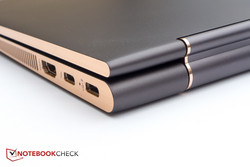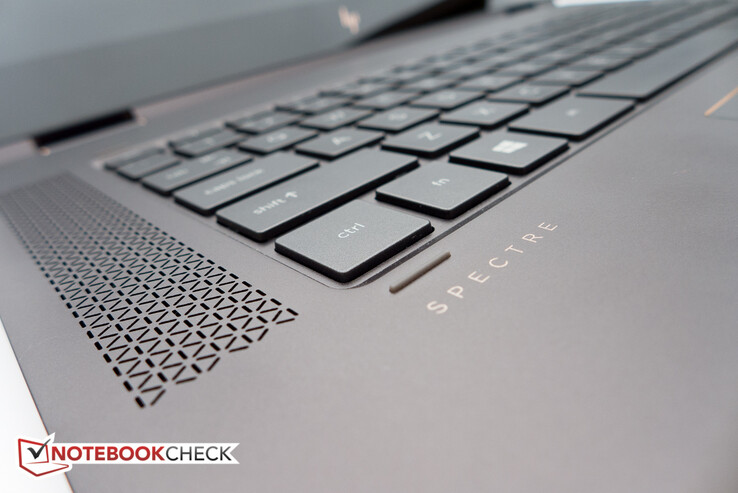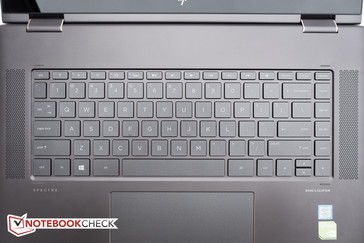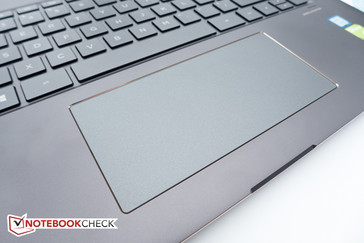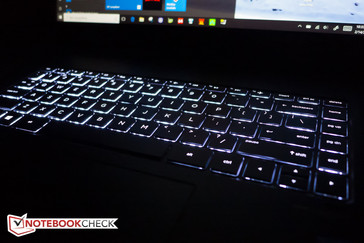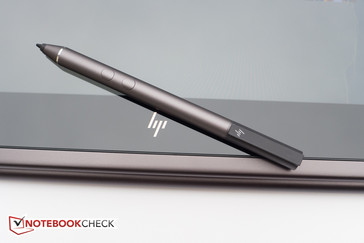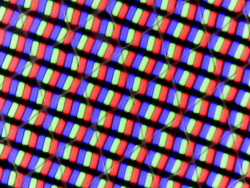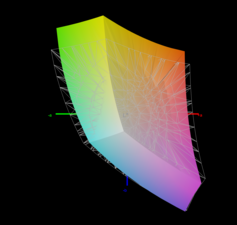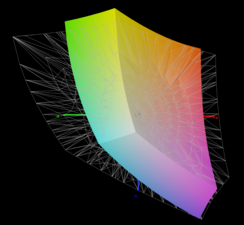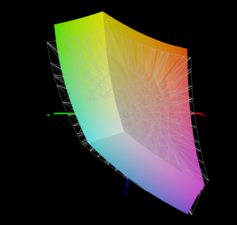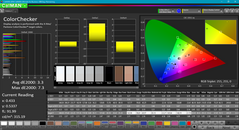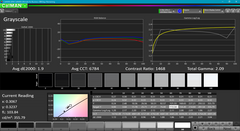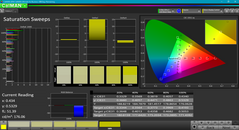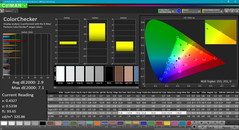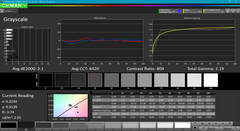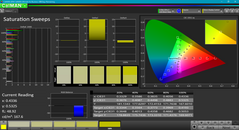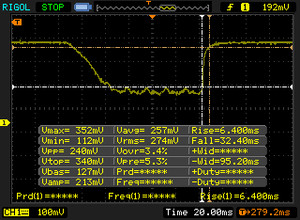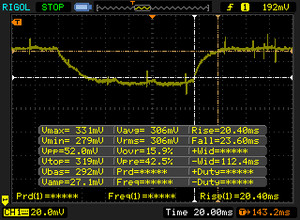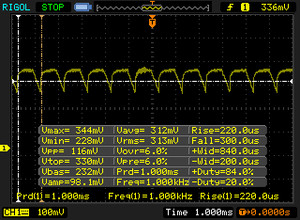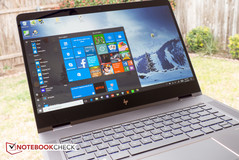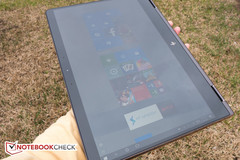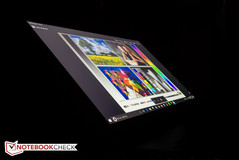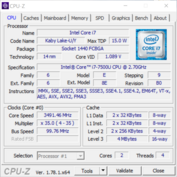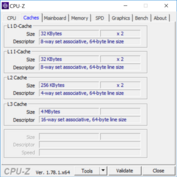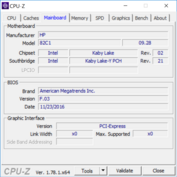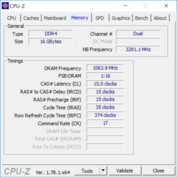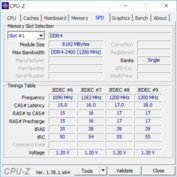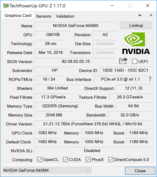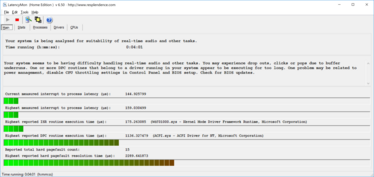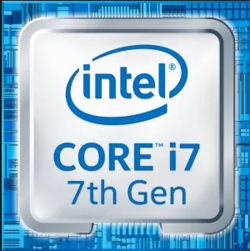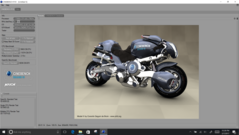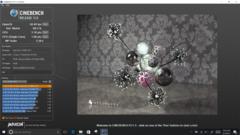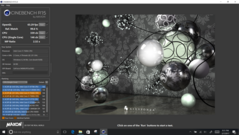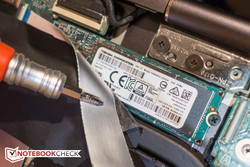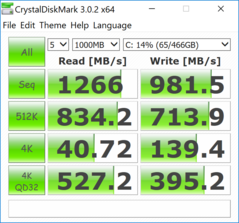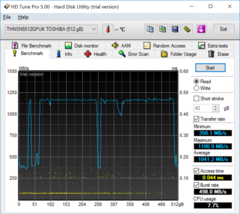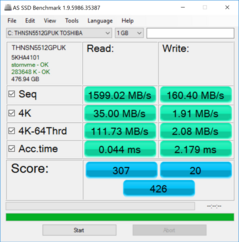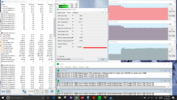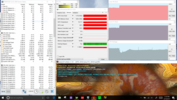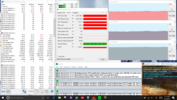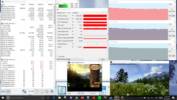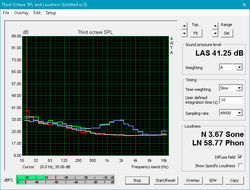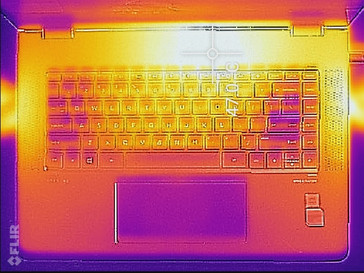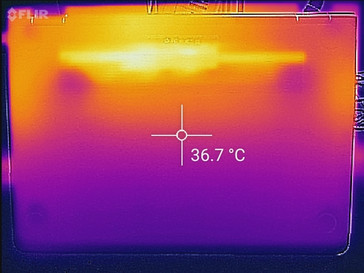HP Spectre x360 15-bl002xx Convertible Review
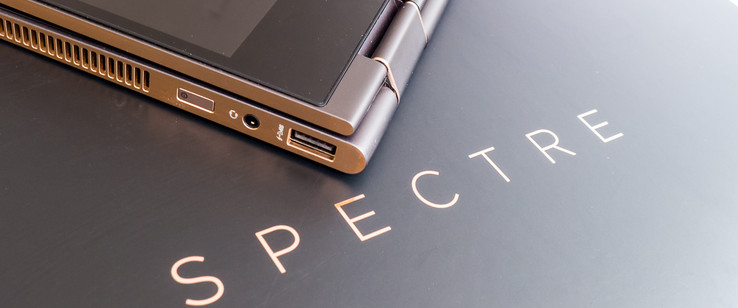
HP's Spectre x360 series of upscale consumer convertibles has been widely regarded as one of the top choices when it comes to 2-in-1 offerings. Last year, the company from Palo Alto took a page out of Dell's playbook with the redesign of the Spectre x360 13-inch, as they incorporated extremely narrow left and right-edge bezels. The Spectre x360 15-inch - we've reviewed both the FHD predecessor as well as the model with 4K display - now gets the same slimming treatment. Aside from the quite obviously new, like the chassis or the switch to a latest-generation processor, there are a few other noteworthy changes as far as the configuration is concerned: the 2017 version makes both the 4K panel as well as discrete graphics in form of a Nvidia GeForce 940 MX mandatory. The sole processor choice is the dual-core Intel Core i7-7500U (2.7 GHz, up to 3.5 GHz, 4 MB cache).
At the time of writing, a user can choose from 8 to 16 GB of RAM and SSDs ranging from 256 GB to 1 TB. While we couldn't locate our particular version - the Spectre x360 15-bl002xx - HP offers the identically-equipped 15-bl075nr for $1500. Compared to the "base" model with 8 GB of RAM and a 256 GB SSD, which sells for $1280, this version ships with 16 GB of RAM and a 512 GB SSD. HP also offers the popular Spectre x360 13-inch FHD with 7th-generation Core i5 processor, 8 GB of RAM and 256 GB SSD for $1050.
Note: we have amended / corrected our review in two areas. Our users have pointed out that the RAM is not soldered on, but upgradeable. Also, a never version of the Synaptics ClickPad software allows the "Right Button Zone" to be configured, so we've taken that into consideration as well.
Update March 7th, 2017: After careful consideration, we have decided to reclassify the Spectre x360 15-inch as a multimedia notebook. Given the Spectre's size and weight on one hand and the 360-degree hinge design on the other, the system actually happens to straddle two of our rating categories. We feel that the Spectre is more of a multimedia laptop which also happens to have convertible features. Please note that the move from one category to the other has affected both the subscores as well as the final score.
Case
The CNC-machined aluminum chassis is strikingly beautiful. The display lid, the keyboard deck and the bottom are "dark ash silver", but the color looks - especially outdoors - more like a slightly purplish charcoal gray to us. The sides and front edges of the notebook, the touchpad-surround and the HP logos are copper-colored; the hinges feature copper accents as well. HP's use of the accent color here is much more restrained than on their super-slim Spectre 13 and the overall result is very pleasing to the eye.
While not quite as sturdy as some other metal semi-unibody designs, the Spectre x360 is torsionally very rigid with no noticeable creaking sounds whatsoever. There is some minor give when pressing down in the middle of the laptop or to the left and right of the touchpad, but not enough so as to be a detriment as far as durability or usability are concerned. The display lid with its Gorilla Glass touchscreen is also quite sturdy and resists twists quite well given it's thickness. Moderately-heavy pushes induce some ripples on the display, however. The metal-encased 360° hinges are not nearly as convincing as the rest of the notebook and in our opinion not quite stiff enough to cope with the heavy display. While it takes two hands to open the lid, the display is actually quite easy to move once in it's in a normal laptop position. In fact, even the action of picking up the x360 can cause the display to swing backwards beyond a 180 degree angle. Tapping on the screen also introduces noticeable wobbles, so the laptop might not be the best choice for train rides and such. The edges of the convertible lack rubber bumpers of any kind, so in tent mode, the unit slides easily on smooth surfaces. Likely this was a design choice to preserve the upscale looks, but we fear that repeated use will scratch the finish in the long run. HP doesn't have an equivalent to Lenovo's lift’n’lock feature, so there's no frame to lock the keys in tablet mode. As good as the surfaces look, fingerprints are unfortunately an issue - even more so, as they aren't easily removed.
As mentioned in our introduction, HP shaved quite a few mm of the bezel, which now measure less than 5 mm each - 4.65 mm to be exact. The company calls the result a "virtually borderless micro-edge display". While the overall width of the notebook has decreased compared to the predecessor - see our size comparison below - the lower-edge bezel is very wide at 3.6 cm / 1.4 inches. so the convertible is slightly deeper, although only marginally so. The thickness has increased as well by about 1.8 mm, but in normal use this is hardly noticeable. The Spectre's footprint most closely matches that of the Dell XPS 15 width-wise, but it's once again deeper by about 1.5 cm (0.6 inches). Even so, for a 15-inch notebook, the HP convertible is exceptionally easy to slip into a bag and carry around.
More noticeable is the increase in weight. Not only has the new version gained about 100 g / 3.5 oz compared to the predecessor, the supplied power adapter is - at 430 g - substantially heavier as well. The total "carry-about" weight has thus increased by roughly 380 g / 13 oz - certainly worth considering if you're planning on lugging the notebook around a lot. The Dell Inspiron 15 convertible weighs about as much as the review 2-in-1; smaller 14-inch convertibles are roughly 450 - 600 g (15 - 20 oz) lighter. The Dell XPS 15 tips the scale at 1.8 kg, so about 200 g / 7 oz less than the Spectre x360 15.
Connectivity
While the predecessor lacked a Thunderbolt port, it's included on this year's version. In addition, the Spectre x360 15 ships with one USB 3.1 Type-A port as well as a USB 3.1 Type-C port. Since both are Gen 1, however, the maximum transfer rate is limited to 5 Gbps. An HDMI port supplies the only dedicated video out, but the Thunderbolt port supports DisplayPort 1.2 as well, so users can always go that route. Note that the 90W power adapter features a USB Type-C plug, so one of the ports is going to be occupied when the laptop is charging.
SD Card Reader
The SD card reader performance is outstanding with a sustained transfer rate of 250 MB/s according to the tool AS SSD. Copying jpeg-picture files to the hard drive is possible at about 126 MB/s. As always, we use our Toshiba Exceria Pro SDXC 64 GB UHS-II Reference card for this test.
| SD Card Reader | |
| average JPG Copy Test (av. of 3 runs) | |
| HP Spectre x360 15-bl002xx | |
| Lenovo Yoga 710-14IKB 80V4002HGE | |
| Dell XPS 15 2017 9560 (7300HQ, Full-HD) | |
| Dell Inspiron 15 5568 | |
| maximum AS SSD Seq Read Test (1GB) | |
| HP Spectre x360 15-bl002xx | |
| Dell XPS 15 2017 9560 (7300HQ, Full-HD) | |
| Lenovo Yoga 710-14IKB 80V4002HGE | |
| Dell Inspiron 15 5568 | |
Communication
The Spectre comes with a 2x2 Intel Dual Band Wireless-AC 8265 module with the antenna integrated into the top bezel. We measured sustained transfer rates of about 625 Mbps for receive and about 500 Mbps for send when connected to our Linksys EA8500 reference router - a very good result. Bluetooth 4.2 is integrated as well. We experienced no issues during the review period and the connection remained stable at all times.
| Networking | |
| iperf3 transmit AX12 | |
| HP Spectre x360 15-bl002xx | |
| iperf3 receive AX12 | |
| HP Spectre x360 15-bl002xx | |
Accessories
The very upscale-looking box contains the notebook, a faux leather sleeve, the 90 W power adapter and the usual setup instruction as well as warranty pamphlet. In addition, HP supplies their HP Active Stylus Pen and three adapters: USB Type-C to VGA, USB Type-C to USB Type-A, and a USB Type-C to RJ45 dongle.
Maintenance
Accessing the hardware requires removal of 6 tiny Torx screws and two additional Phillips screws hidden under the rear plastic/rubber feet so the bottom cover can be taken off. The RAM appears to be soldered on, so the maintenance tasks are limited to cleaning the two system fans or swapping out the M.2 SSD or the wireless module.
Update: according to the user manual, the RAM is upgradable (either 4 GB or 8 GB PC4-2400 will fit).
Warranty
As a consumer/prosumer product, the Spectre x360 15 comes with a standard warranty and is thus protected against manufacturers defects for a period of one year. Additional coverage through HP can be selected at the time of purchase. A Care Pack upgrade to a 2-year warranty with accidental damage protection and free pickup and return service, for example, costs $190 at the time of writing.
Please see our Guarantees, Return Policies and Warranties FAQ for country-specific information.
Webcam
Video conferencing is a mixed bag: while the audio is quite good thanks to dual array digital microphone, the picture quality of HP's "TrueVision FHD" camera leaves to be desired. The test picture on the right was taken in a room with a ceiling fan equipped with 3x 13W (60W equivalent) Sylvania Micro-Mini CFL Soft White light bulbs above and to the left of the notebook. Even though we wouldn't consider this a "low light" shot, the color noise is extremely pronounced - particularly in black areas. Color accuracy is also quite poor with orange rendered as red and the details in Pooh's fur are completely washed out.
Input Devices
Keyboard
At first glance, the keyboard seems to be the same unit as the one used for the Spectre x360 13. Compared to the smaller sibling, key travel has increased though from 1.3 mm to 1.5 mm, however. The keys are slightly concave and spaced at about 3 mm and offer just enough feedback. Typing on the keyboard is very comfortable even at higher speeds and for prolonged periods of time. We don't have too many complaints: we would've liked to see full-sized arrow keys and more than one level of brightness for the backlit keyboard. One other, though fairly minor dislike: the space key in particular makes quite a racket, which might bother noise-sensitive users or users operating in particularly quiet environments.
Touchpad
For a Windows machine, the Synaptics touchpad is exceptionally large at 14 x 6.5 cm (5.5 x 2.6 inches). The etched glass surface is smooth with just the right amount of friction and responds to inputs well even if the fingers should be slightly moist. Given the large surface area, multi-touch gestures like two-finger scrolling or three-finger flick are very easy to perform. The integrated mouse keys work well enough, but right clicks are only recognized in the bottom right quarter both horizontally and vertically and not starting in the middle, as one would assume. As a result, we often executed left clicks when we required a right click. As fitting for a convertible, the keyboard and the touchpad are disabled when the display is folded back.
Touchscreen & Stylus
The 4K touchscreen works flawlessly even into the vary corners and the edges. Flipping the lid all the way around until it rests on the back of the bottom unit puts the convertible into tablet mode. Holding a slate this large and heavy for longer periods time is not necessarily something we particularly enjoy, however. The stylus or "Active Pen", as HP calls it, is powered by a small AAAA battery and features 2 programmable buttons, which can be assigned their function using the HP Pen Control software. In Microsoft OneNote, we found the pen to work smoothly and accurately. The inking capabilities are particularly useful of course with the x360 Spectre 15 in tablet mode for annotating text or marking up images. A drawback: unlike Lenovo's ThinkPad X1 Yoga, the Spectre has no integrated pen holder. The flip side of this coin is that the stylus is a little larger in diameter - more like a real pen - and is thus much easier to hold for longer periods than Lenovo's super-slim integrated unit.
Display
As we mentioned in our intro, HP has made the 15.6-inch UHD UWVA eDP WLED-backlit IPS display with 4K resolution (3840 x 2160 pixels) the sole panel choice. Along with a manufacturer switch - the predecessor with 4K display used a panel from LG Philips, while the new Spectre x360 15 utilizes one from BOE - HP also decided to drop the PenTile-technology in favor of standard RGB , so we ought to see a better contrast ratio this time around.
Thanks to the bonded glass screen combined with the ultra-high resolution, the icons and text are supremely sharp without any apparent graininess. The only caveat: the display doesn't always render older applications and even some newer ones appropriately, so text can be either next to unreadable or fuzzy around the edges because of the scaled view. This is a still somewhat common issue with UHD displays, however and not isolated to the review convertible. Our measurements show an average brightness of about 340 nits, so the new panel is a bit brighter than that of the predecessor, which reached 275 nits. The contrast ratio is better, too, but still far from great at 717:1. While we don't expect the Spectre to compete with the perfectly-black backgrounds of Lenovo's ThinkPad X1 Yoga with OLED display, other panels do much better here. The display of the Yoga 910, for example, is marginally dimmer at 310 nits, but the contrast is essentially twice as high at 1400:1. Subjectively, the panel does look very good, however and the blacks are quite dark.
Backlight bleeding is minimal and restricted mostly to the lower and upper edges of the panel. During normal use, these just marginally brighter spots are next to invisible.
Addendum 03/24/2017: at the request of a reader, we repeated our contrast measurements. This time we measured a contrast ratio of 1465:1. Black level measurements are extremely sensitive especially for displays with higher contrast levels and even a slight black level change will alter the result dramatically. Backlight bleeding and where the screen is measured can also make a measurable difference.
| |||||||||||||||||||||||||
Brightness Distribution: 83 %
Center on Battery: 351.5 cd/m²
Contrast: 1465:1 (Black: 0.24 cd/m²)
ΔE ColorChecker Calman: 3.3 | ∀{0.5-29.43 Ø4.78}
ΔE Greyscale Calman: 1.9 | ∀{0.09-98 Ø5}
88.2% sRGB (Argyll 1.6.3 3D)
64.4% AdobeRGB 1998 (Argyll 1.6.3 3D)
64.4% AdobeRGB 1998 (Argyll 3D)
88.2% sRGB (Argyll 3D)
67.9% Display P3 (Argyll 3D)
Gamma: 2.09
CCT: 6784 K
| HP Spectre x360 15-bl002xx UHD UWVA eDP BrightView WLED-backlit , IPS, 15.6", 3840x2160 | HP Spectre x360 15-ap012dx IPS, 15.6", 3840x2160 | Dell XPS 15 2017 9560 (7300HQ, Full-HD) Sharp SHP1453 LQ156M1, LED IGZO IPS InfinityEdge, 15.6", 1920x1080 | Lenovo ThinkPad X1 Yoga-20FRS1VS00 Samsung ATNA40JU01-0, OLED, 14", 2560x1440 | Lenovo Yoga 710-14IKB 80V4002HGE AU Optronics B140HAN03.0, a-Si WLED TFT, IPS, 14", 1920x1080 | Dell Inspiron 15 5568 AU Optronics B156HW01 V0, IPS, 15.6", 1920x1080 | |
|---|---|---|---|---|---|---|
| Display | -3% | 8% | -3% | -39% | ||
| Display P3 Coverage (%) | 67.9 | 62.8 -8% | 68.9 1% | 62 -9% | 38.04 -44% | |
| sRGB Coverage (%) | 88.2 | 88.2 0% | 98.9 12% | 89.5 1% | 57.1 -35% | |
| AdobeRGB 1998 Coverage (%) | 64.4 | 63.9 -1% | 70.9 10% | 63.3 -2% | 39.3 -39% | |
| Response Times | 27% | -29% | 98% | -3% | 24% | |
| Response Time Grey 50% / Grey 80% * (ms) | 44 ? | 32.8 ? 25% | 54 ? -23% | 1 ? 98% | 53 ? -20% | 42 ? 5% |
| Response Time Black / White * (ms) | 38.8 ? | 28 ? 28% | 52.4 ? -35% | 1 ? 97% | 33 ? 15% | 22 ? 43% |
| PWM Frequency (Hz) | 1000 ? | 240 ? | 50 ? | |||
| Screen | -29% | -33% | -27% | -60% | -32% | |
| Brightness middle (cd/m²) | 351.5 | 298 -15% | 400 14% | 279 -21% | 340 -3% | 266 -24% |
| Brightness (cd/m²) | 336 | 295 -12% | 392 17% | 277 -18% | 302 -10% | 249 -26% |
| Brightness Distribution (%) | 83 | 88 6% | 89 7% | 91 10% | 77 -7% | 85 2% |
| Black Level * (cd/m²) | 0.24 | 0.57 -138% | 0.26 -8% | 0.31 -29% | 0.26 -8% | |
| Contrast (:1) | 1465 | 523 -64% | 1538 5% | 1097 -25% | 1023 -30% | |
| Colorchecker dE 2000 * | 3.3 | 4.43 -34% | 4.9 -48% | 5.15 -56% | 6.75 -105% | 4.98 -51% |
| Colorchecker dE 2000 max. * | 7.3 | 6.62 9% | 11 -51% | 8.28 -13% | 12.4 -70% | 11.82 -62% |
| Greyscale dE 2000 * | 1.9 | 2.45 -29% | 7.2 -279% | 5.44 -186% | 8.47 -346% | 2.68 -41% |
| Gamma | 2.09 105% | 2.45 90% | 2.11 104% | 2.28 96% | 2.22 99% | 2.27 97% |
| CCT | 6784 96% | 6326 103% | 6911 94% | 5686 114% | 6557 99% | 6583 99% |
| Color Space (Percent of AdobeRGB 1998) (%) | 64.4 | 57.2 -11% | 64.2 0% | 98 52% | 58 -10% | 36 -44% |
| Color Space (Percent of sRGB) (%) | 88.2 | 87.8 0% | 98.9 12% | 100 13% | 89 1% | 57 -35% |
| Total Average (Program / Settings) | -2% /
-16% | -18% /
-24% | 36% /
-2% | -22% /
-41% | -16% /
-26% |
* ... smaller is better
At 64 and 88 percent, color coverage for the professional color spaces AdobeRGB and sRGB is just marginally better than that of the predecessor. Users primarily interested in photo or video editing are better served with Thinkpad X1 Yoga, which is near perfect here, or Dell's XPS 15, which covers sRGB at almost 100 percent as well.
Further measurements with the X-Rite i1Pro 2 spectrophotometer and the CALMAN software show good grayscale as well as color accuracy with average DeltaE deviations of 1.9 and 3.3, respectively. A calibration does not noticeably improve the results with red and particularly green showing higher deviations than the other colors at higher saturation levels. For home use, the panel is perfectly acceptable and the quality appropriate for the price point.
Display Response Times
| ↔ Response Time Black to White | ||
|---|---|---|
| 38.8 ms ... rise ↗ and fall ↘ combined | ↗ 6.4 ms rise | |
| ↘ 32.4 ms fall | ||
| The screen shows slow response rates in our tests and will be unsatisfactory for gamers. In comparison, all tested devices range from 0.1 (minimum) to 240 (maximum) ms. » 96 % of all devices are better. This means that the measured response time is worse than the average of all tested devices (20.2 ms). | ||
| ↔ Response Time 50% Grey to 80% Grey | ||
| 44 ms ... rise ↗ and fall ↘ combined | ↗ 20.4 ms rise | |
| ↘ 23.6 ms fall | ||
| The screen shows slow response rates in our tests and will be unsatisfactory for gamers. In comparison, all tested devices range from 0.165 (minimum) to 636 (maximum) ms. » 72 % of all devices are better. This means that the measured response time is worse than the average of all tested devices (31.6 ms). | ||
Screen Flickering / PWM (Pulse-Width Modulation)
| Screen flickering / PWM detected | 1000 Hz | ≤ 99 % brightness setting | |
The display backlight flickers at 1000 Hz (worst case, e.g., utilizing PWM) Flickering detected at a brightness setting of 99 % and below. There should be no flickering or PWM above this brightness setting. The frequency of 1000 Hz is quite high, so most users sensitive to PWM should not notice any flickering. In comparison: 53 % of all tested devices do not use PWM to dim the display. If PWM was detected, an average of 8111 (minimum: 5 - maximum: 343500) Hz was measured. | |||
Unlike the predecessor, the 2017-version of the 15-inch Spectre uses PWM for brightness regulation at any brightness level below 100 percent. Since the frequency is quite high at 1 kHz, even sensitive users are not likely going to experience any discomfort, however.
Outdoor usability is quite decent for a glare-type display thanks to the comparatively high brightness of almost 340 nits, even though the contrast is a little too low. Still, while working in the shade is not too straining for the eyes, direct sunlight or even brighter overcast days are out of the question. Convertibles with much dimmer displays - just about 250 nits in case of the like the Dell Inspiron 15 - are even more at disadvantage here.
Viewing angle stability is - typical for panels based on IPS technology - very good. Even at very shallow angles, the picture remains perfectly visible with no noticeable dimming or color changes.
Performance
While HP sells the smaller Spectre x360 13 with either the Intel Core i5-7200U or the Intel Core i7-7500U processor online, the 15.6-inch Spectre x360 can only be purchased with the i7 CPU. Our configuration for $1500 comes with a 512 GB NVMe M.2 SSD and 16 GB of system RAM, which should guarantee great performance for some time to come. The base model for $1280 comes with 2x 4 GB of RAM. An upgrade to 16 GB DDR4-2133 SDRAM (2x 8 GB) costs $120 more.
Processor
The dual-core i7-7500U (2.7 GHz, up to 3.5 GHz, 4 MB cache, TDP 15 watts) is used in a lot of different mid to higher-end notebooks and convertibles and our sample generally performs as expected. The CPU handles common office and multimedia applications with aplomb and doesn't shy away from heavier processing tasks, either. During the Cinebench R15 multi-test, the processor cores operated at Turbo frequency of 3.1 - 3.5 GHz. Interesting is the fact that the Lenovo Yoga 910, which is equipped with the same CPU but suffers from a more pronounced drop in the Turbo frequency to 2.7 - 2.8 GHz, actually has a slightly higher multi-core score than the review convertible. The Spectre x360 15 outperforms the predecessor with previous-generation Core i5 CPU by roughly 10 and 20 percent for single and multi-core, respectively; systems with a 6th-generation i7 CPU like the Core i7-6500U are roughly 10 % slower.
| Cinebench R10 | |
| Rendering Multiple CPUs 32Bit | |
| HP Spectre x360 15-bl002xx | |
| HP Spectre x360 15-ap012dx | |
| Rendering Single 32Bit | |
| HP Spectre x360 15-bl002xx | |
| HP Spectre x360 15-ap012dx | |
| Cinebench R11.5 | |
| CPU Single 64Bit | |
| HP Spectre x360 15-bl002xx | |
| Lenovo ThinkPad X1 Yoga-20FRS1VS00 | |
| HP Spectre x360 15-ap012dx | |
| CPU Multi 64Bit | |
| HP Spectre x360 15-bl002xx | |
| HP Spectre x360 15-ap012dx | |
| Lenovo ThinkPad X1 Yoga-20FRS1VS00 | |
| wPrime 2.10 - 1024m | |
| HP Spectre x360 15-ap012dx | |
| HP Spectre x360 15-bl002xx | |
| Super Pi Mod 1.5 XS 32M - 32M | |
| HP Spectre x360 15-ap012dx | |
| HP Spectre x360 15-bl002xx | |
* ... smaller is better
System Performance
Compared to the predecessor with i5 CPU and integrated Intel Graphics HD 520, the new laptop is about 12 - 20 percent faster according to PCMark 8. The Dell XPS 15 2017 9560, on the other hand, packs more powerful hardware in form of the quad-core Kaby Lake i5-7300HQ and an NVIDIA GeForce GTX 1050 GPU and pulls ahead by roughly 15 - 20 percent. Perceived performance is excellent with fast boots and application startups. A quick check with 3DMark 11 while the convertible was running on battery power showed no loss in performance whatsoever. During our time with the Spectre, we didn't experience any crashes or encountered unexpected lag.
| PCMark 8 Home Score Accelerated v2 | 3249 points | |
| PCMark 8 Creative Score Accelerated v2 | 4542 points | |
| PCMark 8 Work Score Accelerated v2 | 4016 points | |
Help | ||
Storage Devices
Performance of the SSD - a Toshiba XG4 NVMe THNSN5512GPUK - is great across the board. The capacity of 512 GB should be sufficient for most users, but for those requiring even more storage, HP also offers an upgrade to a 1 TB PCIe NVMe M.2 SSD for an additional $200. We did encounter an issue with the tool AS SSD, which recorded excellent read, but sub-par write rates. We repeated the test several times with near-identical outcome. While we have provided the results below, we need to urge our readers to take the write rates in particular with a grain of salt, as they are quite obviously wrong.
| HP Spectre x360 15-bl002xx Toshiba XG4 NVMe (THNSN5512GPUK) | Lenovo Yoga 910-13IKB-80VF004CGE Samsung PM951 NVMe MZVLV512 | HP Spectre x360 15-ap012dx Sandisk X300 SD7SN6S-256G-1006 | Dell XPS 15 2017 9560 (7300HQ, Full-HD) WDC WD10SPCX-75KHST0 + SanDisk Z400s M.2 2242 32 GB Cache | Lenovo ThinkPad X1 Yoga-20FRS1VS00 Samsung SSD PM961 1TB M.2 PCIe 3.0 x4 NVMe (MZSLW1T0) | Dell Inspiron 15 5568 Toshiba THNSNK256GCS8 | |
|---|---|---|---|---|---|---|
| CrystalDiskMark 3.0 | -1% | -50% | -90% | -4% | -55% | |
| Read Seq (MB/s) | 1266 | 1412 12% | 475.6 -62% | 123 -90% | 1510 19% | 458.6 -64% |
| Write Seq (MB/s) | 982 | 578 -41% | 425 -57% | 74.2 -92% | 1193 21% | 270 -73% |
| Read 512 (MB/s) | 834 | 701 -16% | 258.4 -69% | 101.7 -88% | 397.4 -52% | |
| Write 512 (MB/s) | 714 | 580 -19% | 318.9 -55% | 42.51 -94% | 242 -66% | |
| Read 4k (MB/s) | 40.72 | 43.5 7% | 35.48 -13% | 10.84 -73% | 37 -9% | 19.88 -51% |
| Write 4k (MB/s) | 139.4 | 159.7 15% | 93 -33% | 1.021 -99% | 126 -10% | 86.7 -38% |
| Read 4k QD32 (MB/s) | 527 | 570 8% | 281.2 -47% | 69.8 -87% | 404 -23% | 275.3 -48% |
| Write 4k QD32 (MB/s) | 395.2 | 488.7 24% | 138.7 -65% | 1.057 -100% | 319 -19% | 197.6 -50% |
GPU Performance
The new Spectre x360 15 now comes with a dedicated GeForce 940MX graphics card. The processor-integrated Intel HD Graphics 620 is of course still available as well for transparent switching between low-power 2D and more demanding 3D applications. HP's implementation of the GeForce graphics card is based on the GM108 chip and comes with 384 unified shaders and 2 GB of GDDR5 RAM. The GPU supports DirectX 12 and runs at up to 1189 MHz. Performance according to PCMark 11 is leaps and bounds with the 940MX outperforming the integrated HD Graphics 620 by approximately 60 %. The variant of the 940MX which sees duty in the review convertible with GDDR5 RAM also clearly outperforms the version with DDR3 RAM - according to the PCMark 11 GPU sub-score, the difference is at least 7 percent, but can be as much as 14 percent in case of the Lenovo Yoga 710-14ISK with Intel Core i5-6200U.
| 3DMark 11 Performance | 2772 points | |
| 3DMark Ice Storm Standard Score | 22543 points | |
| 3DMark Cloud Gate Standard Score | 7908 points | |
| 3DMark Fire Strike Score | 1926 points | |
| 3DMark Fire Strike Extreme Score | 969 points | |
Help | ||
Gaming Performance
Compared to the predecessor with integrated graphics only, the gaming performance takes a substantial leap forward as well. While the Intel HD Graphics 520 topped out at 16 fps on low settings while playing Rise Of The Tomb Raider, the 940MX in the review 2-in-1 managed a comparatively smooth 38 fps. Still, despite the increase in performance, users wanting to take advantage of the display's 4K resolution are going to be disappointed: not only is the raw processing power of the GPU not sufficient, but in addition, the 940MX only has access to 2 GB of video RAM, which is not nearly enough for 4K gaming.
| low | med. | high | ultra | |
|---|---|---|---|---|
| Anno 2070 (2011) | 190.1 | 83.2 | 50.5 | 27.1 |
| Sleeping Dogs (2012) | 122.4 | 93.6 | 45.5 | 11.9 |
| Hitman: Absolution (2012) | 77.2 | 56.6 | 27.5 | 10.8 |
| Tomb Raider (2013) | 184.4 | 92.7 | 52.1 | 26.5 |
| BioShock Infinite (2013) | 127.5 | 69.8 | 59 | 21.6 |
| Company of Heroes 2 (2013) | 28.4 | 24.2 | 14.6 | 8.7 |
| Middle-earth: Shadow of Mordor (2014) | 55.3 | 32.5 | 19.3 | 15.1 |
| Rise of the Tomb Raider (2016) | 38.5 | 18.4 | 15.3 | 13.8 |
Stress Test
To identify potential throttling or stability issues, we use the synthetic benchmarks Prime95 and Furmark to stress the CPU and GPU, respectively. With Prime95 running, the CPU maintains the maximum mulit-core Boost of 3.5 GHz only for a few seconds before dropping to 3.1 and then 2.9 Ghz. At about 75 degrees C, the fan kicks in and the temperature drops and subsequently slowly fluctuates between 67 - 71 degrees. When running Furmark on its own, the GeForce 940MX maintained between 1163 - 1176 MHz, so very close to the maximum of 1189 MHz. The temperature started out at 45 degrees C and climbed to around 73 degrees C before stabilizing at 72 degrees C.
Running both Prime95 and Furmark simultaneously will decrease the speed of the CPU cores from the initial 2.9 GHz to 2.7 GHz within the first couple minutes. The temperature of the CPU cores reached 92 degrees C briefly before the fan system spooled up another notch to combat the increase in heat. The CPU cores subsequently stabilized at about 85 degrees C. The GPU meanwhile fluctuates from 1133 - 1163 MHz with the temperature remaining around 73 degrees C. About ten minutes into the test, we encountered throttling for the first time, as the CPU cores dropped from their nominal speed of 2.7 GHz to 2.4 GHz even though the temperature had not increased significantly. Another ten minutes later, the CPU cores had dropped to 2.1 GHz with all other parameters remaining as before. No further changes occurred even after reaching the end of the test period of one hour. A run of 3DMark 11 immediately after showed no decrease in performance.
The Unigine Heaven stress test is representative of real-world loads like gaming and similarly demanding tasks. Here, the CPU and the GPU initially maintained at or just below their respective maximum Turbo-frequency of 3.5 GHz and 1189 MHz, respectively, with the temperatures of the CPU reaching 90 degrees C and the GPU remaining at 71 degrees C. After 15 minutes, the CPU speed had dropped to between 2.6 and 2.7 GHz with the cores at 73 degrees C; the GPU remained as before with the temperature now at about 68 degrees.
#Table_Do NOT_translate!
| CPU Clock (GHz) | GPU Clock (MHz) | Average CPU Temperature (°C) | Average GPU Temperature (°C) | |
| Prime95 Stress | 2.9 | - | 71 | - |
| FurMark Stress | - | 1170 | - | 72 |
| Prime95 + FurMark Stress | 2.1 | 1148 | 72 | 72 |
| Unigine Heaven Stress | 2.6 | 1189 | 73 | 68 |
Emissions
System Noise
The HP Spectre x360 15 is mostly inaudible during idle, as the fans are not running at all, although they do sometimes turns on for no apparent reason with the noise level then jumping to 36 dB. Subjected to medium and high loads, the fan reaches a maximum of almost 43 dB, so the 2017 edition of the Spectre x360 is a bit noisier than the predecessor. Overall, the system is well behaved, although the fan noise during prolonged loads can get annoying after a while. The Dell Inspiron 15 convertible with integrated GPU only tops out at 36 dB, the XPS 15 with much more potent hardware and dedicated reaches an uncomfortable 48 dB under full load.
Noise level
| Idle |
| 28.5 / 28.5 / 36.3 dB(A) |
| Load |
| 42.7 / 42.7 dB(A) |
 | ||
30 dB silent 40 dB(A) audible 50 dB(A) loud |
||
min: | ||
| HP Spectre x360 15-bl002xx GeForce 940MX, i7-7500U, Toshiba XG4 NVMe (THNSN5512GPUK) | Lenovo Yoga 910-13IKB-80VF004CGE HD Graphics 620, i7-7500U, Samsung PM951 NVMe MZVLV512 | HP Spectre x360 15-ap012dx HD Graphics 520, 6200U, Sandisk X300 SD7SN6S-256G-1006 | Dell XPS 15 2017 9560 (7300HQ, Full-HD) GeForce GTX 1050 Mobile, i5-7300HQ, WDC WD10SPCX-75KHST0 + SanDisk Z400s M.2 2242 32 GB Cache | Lenovo ThinkPad X1 Yoga-20FRS1VS00 HD Graphics 520, 6600U, Samsung SSD PM961 1TB M.2 PCIe 3.0 x4 NVMe (MZSLW1T0) | Dell Inspiron 15 5568 HD Graphics 520, 6500U, Toshiba THNSNK256GCS8 | Lenovo Yoga 710-14IKB 80V4002HGE HD Graphics 620, i5-7200U, Samsung MZYTY256HDHP | |
|---|---|---|---|---|---|---|---|
| Noise | 2% | 5% | -7% | 7% | -0% | 4% | |
| off / environment * (dB) | 28.5 | 31.7 -11% | 29.5 -4% | 30.3 -6% | 28.9 -1% | 31.2 -9% | 30.16 -6% |
| Idle Minimum * (dB) | 28.5 | 31.7 -11% | 29.5 -4% | 31.6 -11% | 28.9 -1% | 32.8 -15% | 30.16 -6% |
| Idle Average * (dB) | 28.5 | 31.7 -11% | 29.5 -4% | 31.6 -11% | 28.9 -1% | 32.8 -15% | 30.16 -6% |
| Idle Maximum * (dB) | 36.3 | 31.7 13% | 29.6 18% | 33.4 8% | 28.9 20% | 33.8 7% | 30.5 16% |
| Load Average * (dB) | 42.7 | 38.4 10% | 38.1 11% | 47.8 -12% | 35.3 17% | 36.3 15% | 37.2 13% |
| Load Maximum * (dB) | 42.7 | 34.7 19% | 38.2 11% | 47.8 -12% | 38.9 9% | 36.3 15% | 37 13% |
* ... smaller is better
Temperature
Unlike the predecessor, the new Spectre x360 15 is now equipped with two system fans. The surfaces temperatures are uniformly low at idle with the warmest spot at 34 degrees C just below the HP logo on the lower bezel. During the stress test, this general area reaches 50 degrees C on the bottom. In laptop mode, the location of the hotspot keeps the legs out of harms way, although the same can't be said for tablet mode, as this section now can rest against the underarm depending on how the user carries the device. Still, these extreme temperatures are rarely achieved during everyday use.
(-) The maximum temperature on the upper side is 47 °C / 117 F, compared to the average of 36.9 °C / 98 F, ranging from 21.1 to 71 °C for the class Multimedia.
(-) The bottom heats up to a maximum of 50.2 °C / 122 F, compared to the average of 39.2 °C / 103 F
(+) In idle usage, the average temperature for the upper side is 28.6 °C / 83 F, compared to the device average of 31.3 °C / 88 F.
(+) The palmrests and touchpad are reaching skin temperature as a maximum (33.4 °C / 92.1 F) and are therefore not hot.
(-) The average temperature of the palmrest area of similar devices was 28.7 °C / 83.7 F (-4.7 °C / -8.4 F).
Speakers
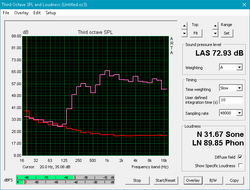
The sound produced by the two stereo speakers - found under perforations to the left and right of the keyboard - isn't exactly a revelation. The speakers are sufficiently loud for an average-sized room, but the sound quality is unfortunately lacking. Although the highs are decent enough and not overly tinny, the lower frequencies are less pronounced while bass is barely detectable at all. The "Bang & Olufsen Audio" app lets the user adjust some basic settings, but in our opinion the tweaks only have a fairly minimal effect. We recommend external speakers or headphones for extended listening sessions. For movies and video clips, the speakers are usuable enought, but there is no question that the Spectre can't compete with a full-sized multimedia laptop.
HP Spectre x360 15-bl002xx audio analysis
(±) | speaker loudness is average but good (72.9 dB)
Bass 100 - 315 Hz
(±) | reduced bass - on average 14.8% lower than median
(±) | linearity of bass is average (14% delta to prev. frequency)
Mids 400 - 2000 Hz
(+) | balanced mids - only 4.4% away from median
(±) | linearity of mids is average (10.1% delta to prev. frequency)
Highs 2 - 16 kHz
(+) | balanced highs - only 1.2% away from median
(+) | highs are linear (4.9% delta to prev. frequency)
Overall 100 - 16.000 Hz
(±) | linearity of overall sound is average (20.3% difference to median)
Compared to same class
» 66% of all tested devices in this class were better, 9% similar, 25% worse
» The best had a delta of 5%, average was 17%, worst was 45%
Compared to all devices tested
» 52% of all tested devices were better, 8% similar, 40% worse
» The best had a delta of 4%, average was 24%, worst was 134%
Apple MacBook 12 (Early 2016) 1.1 GHz audio analysis
(+) | speakers can play relatively loud (83.6 dB)
Bass 100 - 315 Hz
(±) | reduced bass - on average 11.3% lower than median
(±) | linearity of bass is average (14.2% delta to prev. frequency)
Mids 400 - 2000 Hz
(+) | balanced mids - only 2.4% away from median
(+) | mids are linear (5.5% delta to prev. frequency)
Highs 2 - 16 kHz
(+) | balanced highs - only 2% away from median
(+) | highs are linear (4.5% delta to prev. frequency)
Overall 100 - 16.000 Hz
(+) | overall sound is linear (10.2% difference to median)
Compared to same class
» 7% of all tested devices in this class were better, 2% similar, 91% worse
» The best had a delta of 5%, average was 18%, worst was 53%
Compared to all devices tested
» 4% of all tested devices were better, 1% similar, 94% worse
» The best had a delta of 4%, average was 24%, worst was 134%
Frequency Comparison (Checkbox selectable!)
Graph 1: Pink Noise 100% Vol.; Graph 2: Audio off
Energy Management
Power Consumption
The power consumption is comparatively high with the idle power consumption ranging from 8-12 watts - the large 4K display definitely makes its presence known. Load average and maximum are also higher than those of other 14 -15-inch devices with the exception of the Dell XPS 15, which features extremely potent hardware. The maximum power draw exceeds that of the predecessor by 35 watts, which explains why HP switched to a larger (and much heavier) 90 watt power adapter.
| Off / Standby | |
| Idle | |
| Load |
|
Key:
min: | |
| HP Spectre x360 15-bl002xx i7-7500U, GeForce 940MX, Toshiba XG4 NVMe (THNSN5512GPUK), IPS, 3840x2160, 15.6" | Lenovo Yoga 910-13IKB-80VF004CGE i7-7500U, HD Graphics 620, Samsung PM951 NVMe MZVLV512, IPS, 3840x2160, 13.9" | HP Spectre x360 15-ap012dx 6200U, HD Graphics 520, Sandisk X300 SD7SN6S-256G-1006, IPS, 3840x2160, 15.6" | Dell XPS 15 2017 9560 (7300HQ, Full-HD) i5-7300HQ, GeForce GTX 1050 Mobile, WDC WD10SPCX-75KHST0 + SanDisk Z400s M.2 2242 32 GB Cache, LED IGZO IPS InfinityEdge, 1920x1080, 15.6" | Lenovo ThinkPad X1 Yoga-20FRS1VS00 6600U, HD Graphics 520, Samsung SSD PM961 1TB M.2 PCIe 3.0 x4 NVMe (MZSLW1T0), OLED, 2560x1440, 14" | Dell Inspiron 15 5568 6500U, HD Graphics 520, Toshiba THNSNK256GCS8, IPS, 1920x1080, 15.6" | |
|---|---|---|---|---|---|---|
| Power Consumption | 41% | 11% | -19% | 26% | 40% | |
| Idle Minimum * (Watt) | 8.14 | 4.3 47% | 6.5 20% | 6.6 19% | 4.7 42% | 4.34 47% |
| Idle Average * (Watt) | 10.91 | 6.3 42% | 13.3 -22% | 9 18% | 8.6 21% | 7.5 31% |
| Idle Maximum * (Watt) | 12.26 | 9 27% | 15.1 -23% | 10.7 13% | 12.2 -0% | 8.4 31% |
| Load Average * (Watt) | 45.67 | 32.7 28% | 30.8 33% | 77.5 -70% | 29.7 35% | 30.4 33% |
| Load Maximum * (Watt) | 74.94 | 28.8 62% | 38.5 49% | 130 -73% | 50.5 33% | 32.5 57% |
* ... smaller is better
Battery Life
In light of the higher power consumption, HP increased the capacity of the integrated Lithioum-Ion battery from 65 Wh to 79 Wh and promises runtimes of "up to 12.75 hours". During our WLAN test, the Spectre was able to last for nearly 9 hours before shutting down, besting the predecessor by 1.5 hours. This is an impressive result. The Yoga 910, which lacks a dedicated GPU and has a smaller 13.9-inch screen, packs a same-sized battery pack and lasts 2 hours longer. Nonetheless, the Spectre x360 15 should last through an entire work day without requiring an outlet. If charging should be required, HP's Fast Charge technology allows the battery to reach 50 % capacity in just 30 minutes.
| HP Spectre x360 15-bl002xx i7-7500U, GeForce 940MX, 79.2 Wh | Lenovo Yoga 910-13IKB-80VF004CGE i7-7500U, HD Graphics 620, 78 Wh | HP Spectre x360 15-ap012dx 6200U, HD Graphics 520, 65 Wh | Dell XPS 15 2017 9560 (7300HQ, Full-HD) i5-7300HQ, GeForce GTX 1050 Mobile, 56 Wh | Lenovo ThinkPad X1 Yoga-20FRS1VS00 6600U, HD Graphics 520, 56 Wh | Dell Inspiron 15 5568 6500U, HD Graphics 520, 42 Wh | |
|---|---|---|---|---|---|---|
| Battery runtime | 20% | -20% | -39% | -19% | -43% | |
| Reader / Idle (h) | 14.4 | 17.8 24% | 11.8 -18% | 9.4 -35% | 13.7 -5% | 7.5 -48% |
| WiFi v1.3 (h) | 8.9 | 10.7 20% | 7.2 -19% | 5.6 -37% | 5.3 -40% | 5 -44% |
| Load (h) | 2.5 | 2.9 16% | 1.9 -24% | 1.4 -44% | 2.2 -12% | 1.6 -36% |
Pros
Cons
Verdict
HP's newly redesigned 15.6-inch Spectre x360 picks up where the smaller 13.3-inch brother left off. The CNC aluminum chassis is sturdy and feels as good as it looks, despite the fact that it's slightly thicker than before. The updated hardware with Kaby Lake i7 processor and 512 GB M.2 SSD is powerful and also reasonably future-proof. The larger-capacity battery copes well with the increased power requirements and the battery life has improved compared to the predecessor. The 4K panel - now standard RGB instead of PenTile - is bright and vivid, the input devices are decent and the Active Pen makes jotting down notes a pleasurable experience. One of the biggest news is the move to a dedicated GPU, which should appeal to users interested in the occasional gaming session in addition to productivity tasks.
We have comparatively little to complain about: the bonded glass display lid is heavy, so the hinges don't hold it as securely as we would like. There are no protective bumpers of any kind surrounding the base unit or the display, so the convertible slides around on smooth surfaces and the aluminum edges will likely scuff and scratch if the convertible is used in tent mode on less-than-ideal surfaces. 4K displays still suffer from scaling issues at times and not every user needs or wants that high of a resolution, so it would've been nice for HP to offer a Full-HD or WQHD panel at least as an option. Last but not least, a 15.6-inch convertible is large and heavy even if does feature ultra-slim bezels, so its usefulness as a tablet might be somewhat limited.
We can't find many faults with the HP Spectre x360 15. It's a solid, well-performing 2-in-1 and as such one of the best choices when considering a large convertible.
HP Spectre x360 15-bl002xx
- 03/07/2017 v6 (old)
Bernhard Pechlaner




